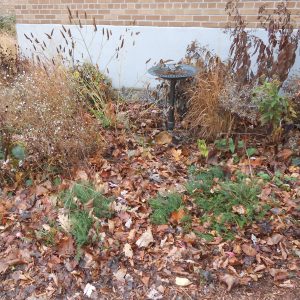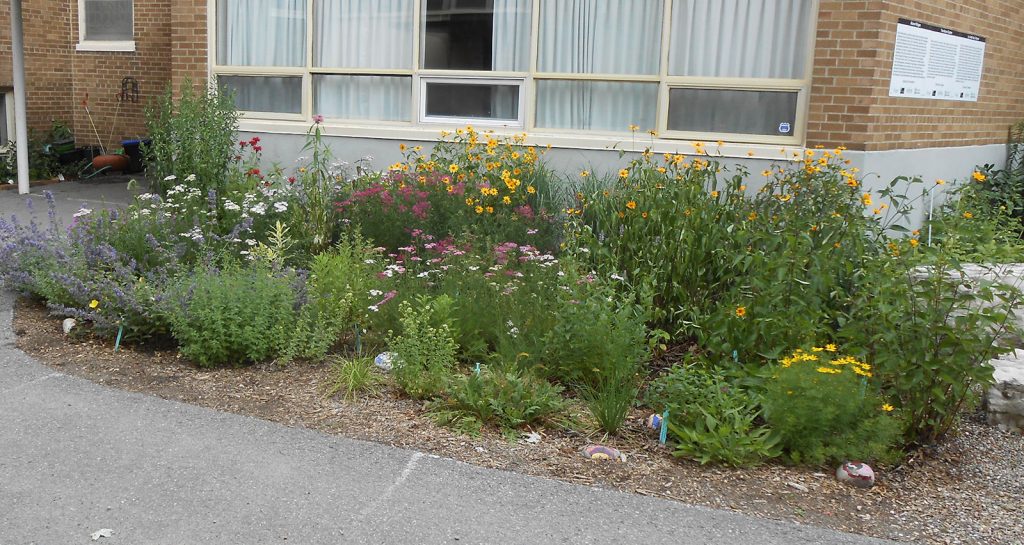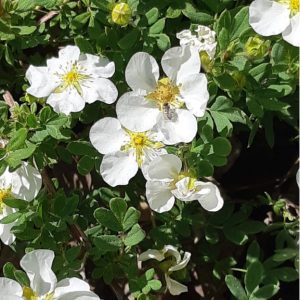by Amanda Carrigan (text and photos)
The Alcove Garden space at Kitchissippi United Church (KUC) was originally pavement. In 2014, KUC members, Ecology Ottawa, and Intact Insurance worked together to remove the asphalt and base to a depth of 20 cm, before adding soil and planting.
In 2020, church members were finding it hard to keep up garden maintenance. As the Master Gardeners of Ottawa-Carleton (MGOC) were meeting in the church, KUC members invited them to take over the garden and maintain it as a wildlife and pollinator friendly, native plant garden, which could be used for educational purposes as well. To this latter end, the garden has an information board and plant labels. Members of MGOC have written articles about some of the plants in their newsletter, Trowel Talk. In 2022, they hosted a Meet the Monarch pollinator education day.
On assuming responsibility for the garden, MGOC began by removing some of the non-native species, and planting native ones, as well as rearranging and editing some of the plantings and doing general maintenance. Both for the environment in general and pollinators in particular, the garden is completely organic – no chemical sprays, no artificial fertilizers. Of course it helps that the focus is on native plants that suit the conditions and are less likely to have diseases, as well as being better supporters of native insect species.

The Alcove Garden, prepared for winter by adding a layer of leaves but with plants left standing to provide food and shelter for wildlife.
Leaves from the red maple in the shade bed are retained and distributed over all the beds to add organic matter. Plant material is left up over the winter, and in the spring, the dead stems are cut down and left in the beds to help feed the plants and provide habitat for invertebrates. Maintenance – weeding, dividing plants, and pruning – is carried out by members of MGOC. Plants are donated by members or purchased from Green Thumb Nursery.
The garden space at the Alcove has both sun and shade areas, and the soil is fairly well drained. Plants were chosen based on these conditions, with the aim of always having things blooming, to support pollinators and wildlife all season.
The smallest bed is the shade bed, with a red maple and large dogwood and snowberry shrubs. In a natural setting, this area would be woodland or woodland edge. This space can be difficult to keep planted as the front half suffers during winter plowing and cars driving over it. Plants in containers have been introduced in the front, and the back includes asters, solomon’s seal, bloodroot, ferns, and Canada columbine.
The rear bed is sheltered and south facing, but its ends are shaded by the building; so, it contains both sun and shade plants. Some woodland/edge plants grow in the shaded area, such as Canada anemone, solomon’s seal, wild ginger, Virginia bluebells, and wild geranium. In the sunnier areas, you’ll find Joe-Pye weed, common milkweed, St. Johnswort, turtlehead, anise hyssop, asters, goldenrod, and beebalm. Many of the taller meadow plants also bloom later in the season.
The largest and most colourful section is the sunny meadow on the east side of the garden. It features a large variety of flowers and grasses, some common, some not. Beebalm, heliopsis, potentilla shrubs, coreopsis, little bluestem and switchgrass, yarrow and wild strawberries, wild roses, and Virginia clematis, are a small sample of the species in this bed.
Sometimes it can be tough to know what a native plant is or what should be included. References may be too general: “native to Ontario”? – well, it’s a big province with different climate zones. Or there may be both native and introduced versions, sometimes hard to tell apart. Yarrow and stinging nettle are examples. We’ve kept yarrow, as it is good for small beneficial insects and grows well here.
Also an issue to consider – now with climate change – some plants that grow well here may be “native” further south and west. As well, this area isn’t known for “prairie” ecosystems, but many urban backyards provide a prairie environment. So the wildlife benefits, the growing conditions, and the actual native range, are all considered when adding plants. There are still non-native plants in the garden, such as catmint, but these are mostly things that do provide some benefit for insects. Gradually they will be replaced with native species.
More about the Alcove Garden from MGOC

